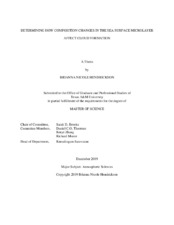| dc.description.abstract | The potential influence of marine phytoplankton on cloud formation has been debated for more than forty years and remains unresolved due to uncertainty in the relative contribution of marine organic matter to cloud droplet formation. In this study, cloud condensation nuclei (CCN) measurements were conducted on aerosolized sea surface microlayer (SML) samples collected during the National Aeronautics and Space Administration (NASA) North Atlantic Aerosols and Marine Ecosystems Study (NAAMES) field campaigns. To determine the contribution of organics in marine sea spray to cloud formation, SML samples were desalinated to remove all salts. The CCN activity of the raw SML and desalinated samples were measured using a CCN counter (Droplet Measurement Technologies, Inc.). Sample composition was characterized using a wideband integrated bioaerosol sensor (WIBS), ion chromatography (IC), and a Shimadzu TOC-V. The analysis from the WIBS showed that aerosols produced from all SML samples and desalinated SML samples contained fluorescing material indicative of marine biological source matter. The CCN activity of SML samples was slightly reduced compared to pure salt and artificial seawater, as indicated by a mean hygroscopicity parameter, κ, of 0.96 ± 0.120 compared to a mean κ value of 1.34 ± 0.004 for NaCl and a mean κ value of 1.28 ± 0.004 for artificial seawater. Desalination of the SML samples decreased κ to a mean value of 0.36 ± 0.050. To provide further insight on specific organic groups present in the samples, κ values were predicted based on the size and chemical composition of the aerosols. The chemical composition of the aerosols was assumed to be salts plus a specific organic compound. The organic concentration was determined assuming the total organic carbon (TOC) in the sample was entirely composed of that specific organic compound. Assuming seven different representative organic components of marine aerosol including humic acid, fulvic acid, glucose, 6-glucose, Ribulose-1,5-bisphosphate carboxylase/oxygenase (RuBisCO), chlorophyll a, and triolein, the κ values of the samples were predicted and compared to the κ values from the CCN measurements. When the aerosol was treated as a mixture of salts and organics where the TOC was assumed to be entirely composed of RuBisCO, provided the closest predicted κ value to the measured κ value for the desalinated SML samples.
The κ values predicted using an organic composition of RuBisCO for the desalinated SML samples ranged 0.44±0.087. Based on these results the best κ prediction for the raw SML samples would be a mixture of RuBisCO and NaCl. Varying the organic composition when predicting the κ values for the SML samples showed that the influence of the organics was insignificant compared to the influence from the salts on the κ values. The range of κ values across all the organic compositions considered for the SML samples was 1.28 ± 0.004. This range of κ values matches the calculated κ values for artificial seawater, indicating that the salts present in artificial seawater largely influence the κ values for the SML samples. While the presence of organic material in the ocean surface waters may increase aerosol mass, cloud formation potential will be slightly weakened or unchanged compared to sea spray aerosol. | en |


